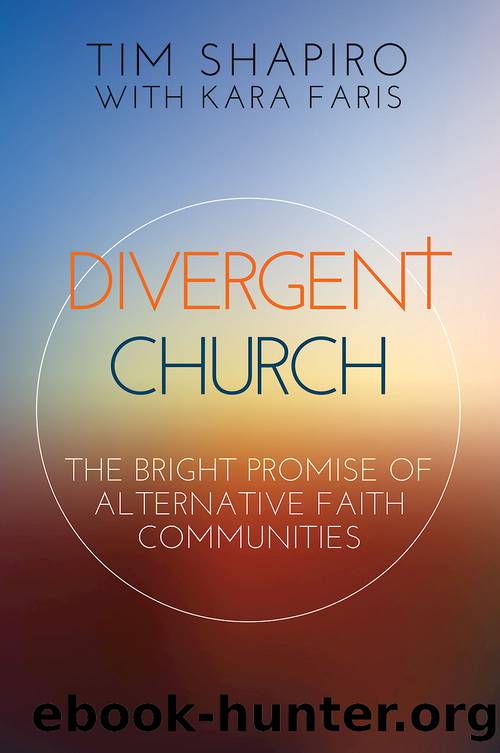Divergent Church by Shapiro Tim;Faris Kara;

Author:Shapiro, Tim;Faris, Kara;
Language: eng
Format: epub
Publisher: Abingdon Press
Published: 2017-08-15T00:00:00+00:00
Art and Faith Converging
This story represents how the practice of artistic expression provides opportunities to interpret experiences of faith and life. It also invites observations about interpretation in divergent churches. Consider Rembrandtâs painting Return of the Prodigal Son. In the painting, the fatherâs hands are on the prodigal sonâs shoulder and upper back. What are the hands doing? Are they giving a blessing? Are they comforting? Are they pulling the son close? Are the hands pressing firmly or lightly? Are the hands warm or cool? Making meaning out of those hands is fun and engaging. Thereâs no answer because no one can ask Rembrandt. And who knows? Maybe Rembrandt was just trying to draw the most lifelike hands he could draw. But we are free to interpret. We are drawn to engage the art, to experience it on a deeper and multifaceted level. The responsibility of response is given to us, and the act of response is itself a form of artistic expression. In divergent churches, meaning-making as it occurs through a variety of practices is given to the community to discern.
At Convergence, interpretation and subsequent meaning-making occur through artistic expression. We have experienced this as a unique element of divergent churches. In more established congregations it is often, depending on the polity of the church, decision making about the church that is collaborative; that is, decision making about strategies and operations are given to members as part of their work as members. Some, maybe many, of the divergent churches we learned from were not highly collaborative when it came to shaping community or making institutional decisions. Often there was a small guiding group or the lead clergy held the vision and made operational decisions. However, concerning matters of meaning-making and interpretation of faith, the divergent churches become egalitarian. The more voices the better. Your expression, your interpretation is valid.
In the world of religion and spirituality, we often try to stake our claim in certain schools of thought. Iâm progressive. You are evangelical. She finds comfort in the immanence of God. He seeks transcendence. Like other spheres of life, church life is often exemplified by categorical thinking. We attach ourselves to groupings and classifications. The danger is that the grouping or classification becomes who we are. Expressing spirituality and faith through artistic interpretation reminds us that there is room to experience and interpret deep truth anew, sometimes beyond categories. Fresh interpretation is rooted in the present, in the here and now of any given moment. The people of Convergence engaged in fresh interpretation when they reenacted the anointing of Jesusâs feet.
Then weâre back on the set of Fool for Love with the people of Convergence.
âWhat would you say?â asks Lisa.
When Dan said, âThank you,â Lisa thought, Of course. Of course thatâs what youâd say!
And then she reflects that if she were acting as Jesus, she would probably have responded to âthank youâ with âyouâre welcome, my childâ or something else that sounds gracious and holy.
But Kathyâs response of âYou moved meâ is unexpected.
Download
This site does not store any files on its server. We only index and link to content provided by other sites. Please contact the content providers to delete copyright contents if any and email us, we'll remove relevant links or contents immediately.
Fangirl by Rainbow Rowell(9104)
How to Bang a Billionaire by Alexis Hall(8075)
Wonder by R. J. Palacio(8014)
The Space Between by Michelle L. Teichman(6864)
The Thirst by Nesbo Jo(6832)
Assassin’s Fate by Robin Hobb(6134)
Wiseguy by Nicholas Pileggi(5674)
The Night Circus by Erin Morgenstern(5159)
Paper Towns by Green John(5092)
The Kite Runner by Khaled Hosseini(5087)
Bittersweet (True North #1) by Sarina Bowen(4806)
Gerald's Game by Stephen King(4584)
Too Much and Not the Mood by Durga Chew-Bose(4278)
Pillow Thoughts by Courtney Peppernell(4214)
Goodbye Paradise(3729)
Twelve Days of Christmas by Debbie Macomber(3519)
Good by S. Walden(3489)
The Rosie Effect by Graeme Simsion(3375)
The Cellar by Natasha Preston(3264)
